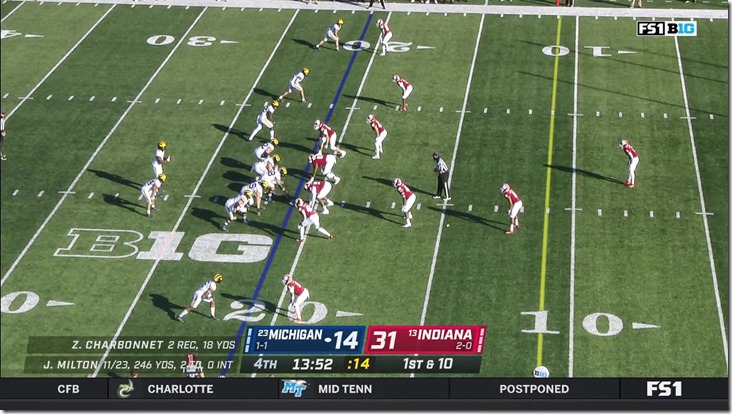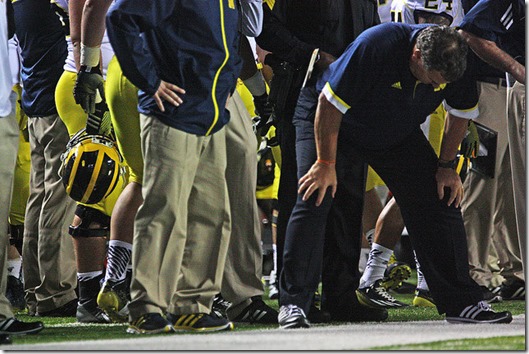al borges devin gardner prostyle cuisine

FORMATION NOTES: All gun, and the vast majority was three-wide with Eubanks and three WRs in.
Indiana responds by having a box that looks light and then sending someone down to either blitz off the corner or adding a safety to the linebacker level. Or just running a light box and hoping to get away with it.
SUBSTITUTION NOTES: With Hayes and Mayfield out the line was Barnhart/Filiaga/Vastardis/Zinter/Stueber. Eubanks returned and got the large majority of snaps; Erick All was involved somewhat but after another drop he barely saw the field.
The usual at WR with Bell leading the pack; felt like Cornelius Johnson slid into the #2 role both by targets and snaps. Sainristil, Wilson, and Jackson were tightly bunched behind. Henning continues to get snaps; here he had more than his previous bare handful.
Same near-even four-man rotation at RB. Ben Mason's role was significantly reduced.
[After THE JUMP: Milton is legitimately promising, at least]
What is the difference between this run:
…and this run:
?
If you guessed "the one Harbaugh/Drevno were coaching got yards and the one from Hoke/Borges didn't" you win a running theme of the 2015 offseason. The results are certainly stark; why that's true is what we're interested in.
The Power Play
These are both the same play by the offense, and the same play Brady Hoke promised to make into Michigan's base because it is the manliest of plays. It is Power-O, the one where you pull the backside guard and try to run between the tackles.
You can click for biggers
The play is relatively simple to draw up and complex to execute because it uses a lot of the things zone blocking does, including having the blocking and back react to what the defense does. For all the "manball" talk this isn't ISO, where you slam into each other quickly. Depending on how the coach wants to play it and what defensive alignment you see, the basic gist is to get a double or scoop of the playside DT and kick out the playside DE, then have an avalanche of bodies pour into that hole—if the defense is leaping into that gap you adjust by trying a different hole further outside. Leaving two blockers to seal off the backside, one blocker, usually the backside guard, pulls and becomes the lead blocker—it's up to him to adjust to what he sees when he arrives.
You can run this out of different formations with different personnel, and the one immediately apparent difference in the above diagrams is Michigan was more spread—a flanker (Z) is out on the opposite numbers and the strongside is to the boundary; after the motion this is an "Ace Twins". Stanford ran this with a heavy "22-I" formation, meaning two backs (RB and FB) and two tight ends (Y and H) in an I-form. The benefit Michigan gets from its formation is the guy Stanford would have to block with its fullback Michigan has removed from the play entirely by forcing him to cover the opposite sideline.
What Stanford gets in return for its fullback is matchup problems: the open side of the field is going to be two tight ends and a fullback versus two safeties and a cornerback. Run or pass that can go badly for the defense as these size mismatches turn into lithe safeties eating low-centered fullbacks, and dainty corners on manbeast TEs.
In War of 1812 terms, Michigan is the Americans, sending the fast-sailing frigate Essex in the Pacific so the enemy has to move ships to the Galapagos instead of harassing the Carolinas. Stanford is the British, parking 74-guns ships of the line where engaging them cannot be avoided and trusting the outcome of any forced engagement should turn in their favor. The point is both work to the advantages and disadvantages of the talent on hand. (In this analogy Borges is a guy trying to use Horatio Nelson tactics with a Navy of sloops and brigs).
That being said, it still works as well as anything—people did in fact score points before the spread, and those who scored a lot of them could do so by keeping defenses off balance and with good execution. As we'll see both of those factors played a big role.
[after the jump]
[Adam Glanzman]
“Sometimes, there's a man, well, he's the man for his time and place. He fits right in there. And that's the Dude, in Los Angeles… But sometimes there's a man, sometimes, there's a man. Aw. I lost my train of thought here. But... aw, hell. I've done introduced him enough.” –The Stranger, The Big Lebowski
In mid-2010 I got hired by a bank to be a Customer Service Representative teller. This put me on the front lines of the never-ending war between people’s money and the financial organizations that hold it. I learned very quickly that there were two things that could turn a mild-mannered citizen into a venom-spewing troglodyte: bank fees and Rich Rodriguez.
I loved when people came into the bank wearing college gear because it meant I’d be able to easily strike up a conversation about football, and people are a little less likely to verbally assault you when you’re able to find some common ground. The operative word in that last sentence is “little,” but I digress. By the fall of 2010 people were so fixated on the abject disaster that was Michigan’s defense that they willfully ignored how incredible the offense was. This was the fuel they needed to turn the “RichRod isn’t a ‘Michigan Man’” fire into a raging inferno, and it got so out of control that I talked to people who were even criticizing Rodriguez’s wife for not being Michigan-y or Michigan-ish or something crazy like that. At one point someone complained to me about her having blonde hair.
The Microscope of Public Scrutiny was so zoomed in on Rodriguez and everything surrounding him that Dave Brandon was able to make the Free Press look stupid and then lie in wait. At some point in 2010 Brandon’s opinion aligned with the bank’s clients; to them, the Rodriguez experiment had failed. Enter: Brady Hoke.
Hoke represented everything that the anti-Rodriguez movement wanted: familiarity with the program, a defensive background, and the mixture of self-oriented humility manifest in his claim that he’d walk across the country for the job and the program-oriented bravado in the interminable fergodsakes claim.
The honeymoon phase lasted a full season, but by the end of Hoke’s fourth year the program was in a place similar to where he found it, a place all too familiar to Michigan’s fanbase. One side of the ball was above average, but the other side was in such shambles that the team collapsed under the dead weight.
**********
"Once we get the power play down, then we'll go to the next phase. You know, because we're gonna run the power play."
Brady Hoke, 3/23/2011
The transition from Rich Rodriguez to Brady Hoke was like switching from cold brewed coffee to run-of-the-mill drip coffee; a move away from the newer, higher-octane movement and toward what felt more traditional, the tried and true. The fallout from this was immediately apparent in the speculation that one of the most dynamic players to every don the winged helmet might transfer to a school with an offense better suited to his talents (i.e. a school that wouldn’t put him under center and have him hand the ball off).
In what may be one of the most significant events in program history (more on that later), Denard stayed. Al Borges still tried to put Denard under center and Michigan did rep power, but there were enough zone reads incorporated to allow Denard to continue waking up opposing defensive coordinators in cold sweats. You know all of this. You watched it unfold. That also means you watched crimes perpetrated against manpanda and an offense hell-bent on skinning its forehead running against a brick wall before finally, mercifully, abandoning their MANBALL-big-boy-football-noises ideals and exploding out of the shotgun.
This piece is intended to be the counterpoint to the memory’s emphasis on the spectacular. The intent isn’t to accuse, but to take a more calculated look at what exactly happened to Michigan’s offense over the last four years and see where things went well, as well as where and how things stopped functioning.
[After THE JUMP: charts and tables]




99